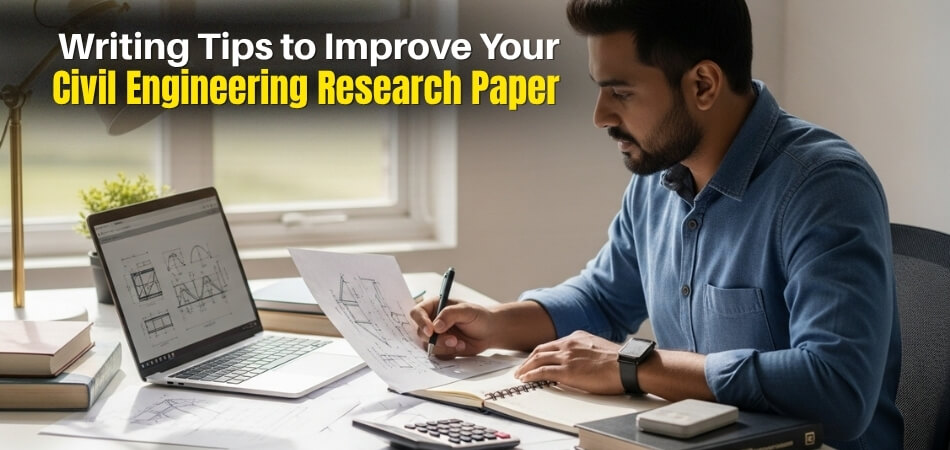Writing research papers in civil engineering can feel difficult, especially if you are not used to it. You have to explain your ideas clearly and organize your paper in a simple way. Many people find it hard to make their research easy to read and understand. That’s why knowing the right steps can really help.
In this article, you will find 5 writing tips to improve your civil engineering research paper. These tips are easy to follow and will help you write a better paper, whether you are a student or already working in the field. By using these tips, you can share your research in a clear and effective way.
5 Writing Tips to Improve Your Civil Engineering Research Paper
Clear structure and strong ideas can make your civil engineering paper easier to read and more impactful. The right approach helps your research connect with readers and stand out. Here are five simple tips to improve your paper.

Provide a Proper Introduction and Context
- Set the stage for your topic by giving a simple overview of the civil engineering problem or area your work addresses. Show readers why your research matters by connecting it to everyday life or bigger world issues.
- Let your audience know how your findings might impact society, the environment, or even the economy in clear language. Share background information in a way that people from different fields can still follow along.
- Define any abbreviations or special words as soon as you introduce them, even if they seem common to you. Remember that readers might not be familiar with technical terms, especially if they come from other fields.
- Relate your research to events or meetings, such as conferences in USA, Canada, or Germany, where professionals share the latest findings and ideas.
Use Clear Structure and Logical Flow
- Arrange your paper into clear sections like Introduction, Methods, Results, and Discussion for a smooth reading experience. Make sure each section follows naturally from the one before it, avoiding jumps or gaps.
- Keep section titles simple and direct so readers know what to expect next in your paper. Use short, helpful linking sentences between paragraphs to lead readers from one point to another.
- Give every paragraph its own focus, and avoid putting too many ideas into one place. If you find the flow getting lost, read your work aloud to spot confusing areas.
- When you finish one part, check if readers will know why it matters before you move on to the next section.
Write Clearly and Concisely
- Choose simple words that express your ideas without making readers guess your meaning or look up definitions. Write in a direct way, saying what you mean without adding extra or fancy language.
- Use active verbs as much as possible, since they make your sentences easier to read and less confusing. Avoid very long sentences; instead, split big ideas into two clear statements.
- Get rid of words that do not add meaning or help your argument, such as “very” or “really.” Repeat important points only when you need to, not to fill space.
- Review your sentences for any extra or confusing words, trimming them to keep your message sharp and focused.
Support Arguments With Critical Analysis
- Check other research papers and books to see what others have already found about your topic. Point out where your work fits in with or adds to this existing research.
- Always show the difference between your new findings and ideas from other writers. Talk about what is good or not so good about previous research, giving examples when possible.
- Choose sources that are up-to-date and written by trusted experts, such as recent journal articles or reports. Show that you understand both the strengths and weaknesses in the current research area.
- Find gaps in the research and explain how your paper helps to fill them, adding something new to the field.
Revise, Edit, and Use Visuals Effectively
- Look over your paper several times to catch mistakes and improve your ideas before sharing it with others. Ask a friend or teacher to read your draft and give you honest feedback.
- Check that your arguments make sense and follow a clear path from start to finish. Fix grammar, punctuation, and spelling errors for a more professional result.
- Add charts, graphs, or tables to show your data in a way that is easy to see and understand. Make sure every visual has a title and you mention it in your text, so readers know what to look for.
- Use visuals only when they add value to your points and make complex data easier to follow for everyone.
What Are the Most Effective Strategies for Selecting a Relevant Civil Engineering Research Topic?
A civil engineering research topic can be challenging when you’re just starting out. You might have lots of ideas, but picking the best one feels hard. Sometimes it helps to look around and see what interests you the most. With the right steps, finding a topic becomes much easier and even fun. Here are some:
Identify Your Interests and Strengths
Think about what parts of civil engineering you like the most. Maybe you enjoy building bridges, working with water, or understanding how buildings stay safe. You will do better if you choose a topic that matches your strengths. It is easier to stay motivated when you care about what you are learning. Your interests can help you decide on a topic that feels right for you.
Review Current Trends and Challenges
Check what is happening in civil engineering right now. Look for news, online articles, or videos that talk about new projects or problems. Sometimes, new technology or climate issues bring up big questions to solve. Knowing what people are working on can give you great ideas for your own topic. This way, your research will feel important and up-to-date.
Consult With Advisors and Industry Experts
If you feel stuck, ask teachers, older students, or people who work in civil engineering for advice. They can share what topics are interesting or useful these days. Sometimes, an advisor will point out ideas you never thought of before. Talking to experts makes you more confident about your choice. They can also suggest easy ways to get started.
Analyze Real-World Problems
Look around your city or town and notice any engineering problems. Maybe there are roads that flood when it rains or buildings that need repairs. Real problems often inspire the best research topics because you want to help fix them. Think about what bothers you or your friends and how you could help. Real-world issues can make your research meaningful and exciting.
Explore Interdisciplinary Opportunities
Sometimes, the best topics mix civil engineering with other subjects, like computers, the environment, or even art. Working across different fields helps you see new connections and ideas. Try thinking about how engineers and other experts work together on big projects. Mixing subjects makes your topic unique and more interesting. This can also open up more ways to solve problems.
Assess Feasibility and Resources
Before you choose, check if you have the things you need to work on your topic. Some ideas might need special tools, books, or help from others. Make sure your topic is something you can actually do with what you have. This helps you avoid getting stuck later. Picking a topic you can finish will make the project less stressful.
Conduct a Literature Review
Read what other people have already said about your idea. Find simple articles, books, or videos to see if your topic has enough information. If there is a lot of research, you can learn from it and find new questions to ask. If there is not much, you may have found a new area to explore. Checking what’s out there helps you pick a topic that matters.
Align with Industry and Funding Priorities
Some topics get more attention because companies or governments need answers quickly. Look for topics that match what big projects or businesses care about right now. If you pick something people want to solve, your research can have a bigger impact. It may even help you get support or resources for your project. Stay aware of what the industry needs at the moment.
Consider Scalability and Impact
Think about whether your topic could help many people or only a few. Small topics are easier to manage, but big topics might change more lives. Decide how much time and effort you can give to your research. Topics that help others or solve big problems often feel more rewarding. Imagine the difference your work could make.
Stay Flexible and Iterative
Be open to changing your topic as you learn more. Sometimes your first idea will not work out, or you find something even better. Do not worry if you need to switch or make changes along the way. Learning from mistakes or new ideas is part of research. Stay flexible and enjoy the process of finding what interests you most.
How to Structure Your Civil Engineering Research Paper to Enhance Clarity and Credibility?
Structuring a civil engineering research paper effectively is essential for ensuring clarity, coherence, and credibility. A well-organized paper communicates your findings professionally and enhances its impact in academic and industry circles. Below are key strategies for structuring your paper for civil engineer conferences:
1. Follow a Standard Structure
Adopt the widely accepted IMRaD format (Introduction, Methods, Results, and Discussion), supplemented with additional sections common in civil engineering papers. The typical structure includes:
- Title: Create a concise, specific, and descriptive title that reflects the research focus (e.g., “Optimizing Reinforced Concrete Beams Using Machine Learning for Seismic Resilience”).
- Abstract: Summarize the research problem, objectives, methods, key findings, and significance in 150–250 words. Ensure it’s clear and engaging to draw readers in.
- Keywords: Include 4–6 relevant terms (e.g., “sustainable construction,” “finite element analysis,” “bridge maintenance”) for discoverability in databases like ASCE Library or Scopus.
- Introduction:
- State the research problem and its significance in civil engineering (e.g., addressing infrastructure durability or urban flooding).
- Provide background context and a brief literature review to highlight the gap your research addresses.
- Clearly articulate the research objectives and, if applicable, the hypothesis.
- Literature Review: Detail prior work in the field, citing recent studies from journals like the Journal of Structural Engineering or Transportation Research. Identify gaps or limitations that justify your research.
- Methodology:
- Describe the research design, including experimental setups, simulations (e.g., using software like SAP2000 or MATLAB), or data collection methods.
- Specify materials, equipment, or standards used (e.g., ASTM codes for concrete testing).
- Justify your approach to establish credibility (e.g., why a particular finite element model was chosen).
- Results: Present findings objectively using tables, graphs, or figures (e.g., stress-strain curves, load-displacement graphs). Ensure visuals are clear, labeled, and referenced in the text.
- Discussion:
- Interpret results in the context of your objectives and existing literature.
- Highlight implications for civil engineering practice (e.g., cost savings, safety improvements).
- Address limitations and suggest future research directions.
- Conclusion: Summarize key findings, their significance, and potential applications. Avoid introducing new information.
- References: Cite all sources using a consistent style (e.g., APA, ASCE, or IEEE). Include peer-reviewed journals, conference papers, and standards relevant to civil engineering.
- Appendices (if needed): Include supplementary data, calculations, or detailed methodologies (e.g., finite element model parameters).
2. Enhance Clarity
- Use Clear Language: Avoid jargon unless necessary, and define technical terms (e.g., “shear capacity” or “geotechnical stability”) for broader accessibility.
- Logical Flow: Ensure each section transitions smoothly. For example, link the literature review to your methodology by explaining how your approach addresses identified gaps.
- Visual Aids: Use high-quality figures, such as structural diagrams or flowcharts, to clarify complex concepts (e.g., a schematic of a bridge retrofitting technique). Label axes and include units (e.g., kN for force, MPa for stress).
- Concise Writing: Be direct and avoid redundancy. For instance, instead of “the results that were obtained from the experiment,” write “the experimental results.”
3. Boost Credibility
- Cite Authoritative Sources: Reference recent, high-impact journals or standards (e.g., ACI 318 for concrete design, Eurocode for structural analysis) to ground your work in established knowledge.
- Detail Methodology: Provide enough detail for reproducibility. For example, specify the type of cement used or the boundary conditions in a simulation.
- Acknowledge Limitations: Transparently discuss constraints (e.g., small sample size, simplified assumptions in modeling) to demonstrate rigor.
- Validate Results: Compare findings with existing studies or industry benchmarks to reinforce reliability. For example, if studying concrete strength, compare results to ACI or ASTM standards.
- Peer Feedback: Before submission, seek feedback from advisors or colleagues to refine clarity and address technical inaccuracies.
4. Align With Civil Engineering Context
- Emphasize Practical Applications: Highlight how your findings benefit infrastructure design, construction, or maintenance (e.g., cost-effective materials for low-income housing).
- Incorporate Standards and Codes: Reference relevant engineering standards (e.g., ASCE 7 for seismic design) to align with industry expectations.
- Address Sustainability: Where applicable, discuss how your research supports sustainable practices, a key focus in modern civil engineering (e.g., reducing carbon emissions in construction).
5. Formatting and Presentation
- Adhere to Journal Guidelines: If targeting a specific journal (e.g., Journal of Construction Engineering and Management), follow its formatting, citation, and length requirements.
- Use Professional Software: Prepare figures and tables using tools like AutoCAD, MATLAB, or Excel for precision and clarity.
- Proofread Thoroughly: Eliminate grammatical errors and ensure technical accuracy to maintain professionalism.
Why is It Important to Include Technical Keywords in My Research Paper and How to Choose Them?
When you write a research paper, you want people to read and understand your work. Using the right words makes your paper easier to find online and in libraries. Good keywords help show what your paper is about and why it matters. If you choose them carefully, your work can reach more people in your field. Here few clear reasons to use the right technical keywords in your research paper.
Enhance Discoverability
Picking good technical keywords means more people can find your paper when they search online. Researchers from different places will see your work when they look up related topics. This helps your ideas reach a bigger audience, not just people in your school or town. When your paper is easier to find, it can help others learn new things. More readers also mean more chances for your work to make a difference.
Clarify Research Scope
Technical keywords show readers exactly what your paper covers, even before they start reading. If someone wants to know about a special part of civil engineering, your keywords point them in the right direction. This helps readers know if your paper is helpful to them. Clear keywords also save time because people can quickly decide if your paper matches what they need. Well-chosen words make your research easier to understand.
Align with Industry Standards
Using popular keywords shows that you know what is important in your subject. This makes your paper fit better with what experts are talking about right now. When you submit a research paper to a civil engineering conference, the right keywords make your work match current trends. Reviewers and readers will see that you are up to date with your topic. This can help your paper get noticed and respected.
Facilitate Peer Review and Publication
When you use the best keywords, editors and reviewers know right away what your paper is about. This helps them decide if your work fits their journal or conference. If your keywords match their interests, your paper can move through the review process faster. Reviewers also find it easier to check your paper if they understand the key topics. Choosing good keywords can make publishing your work much smoother.
Support Interdisciplinary Research
Civil engineering often connects with other subjects, like the environment or computers. Good keywords show how your paper links to these different areas. Other researchers who work outside of civil engineering can find your work if you use the right words. This can lead to new ideas and teamwork with people from different fields. Your keywords help bring together a wider group of readers.
Improve Indexing and Citations
Research papers are saved in big databases and libraries, where people search using keywords. When your paper has strong keywords, it is easier for others to find and use in their own work. This can lead to more people mentioning your paper in their projects or research. More citations make your work more important in your field. Choosing the right keywords helps your research stay useful for a long time.
Common Formatting Mistakes to Avoid in Civil Engineering Papers to Meet the Standard
To meet professional civil engineering standards, a research paper must adhere to strict formatting and presentation expectations, as these enhance clarity, credibility, and compliance with academic and industry norms. Below is a concise list of common formatting mistakes to avoid, tailored to civil engineering research papers, along with guidance to ensure alignment with standards like those of ASCE, ICE, or other reputable journals. Here are the common formatting mistakes to avoid:
Inconsistent Citation Style:
- Mistake: Mixing citation styles (e.g., APA, IEEE, or ASCE) or incorrectly formatting references (e.g., missing journal volume numbers or DOIs).
- Solution: Choose the citation style specified by the target journal (e.g., ASCE uses author-date format: Smith et al. 2023). Use tools like Zotero or EndNote to ensure consistency. Include all required details, such as page numbers or standard codes (e.g., ASTM C39).
- Example: Incorrect: Smith, J. 2020. Journal of Structural Engineering. Correct: Smith, J., & Lee, K. (2020). Seismic retrofitting techniques. Journal of Structural Engineering, 146(3), 04019234.
Poorly Designed Figures and Tables:
- Mistake: Using low-resolution images, unclear labels, or missing units in figures (e.g., stress-strain curves without MPa units) and tables (e.g., unnumbered or untitled tables).
- Solution: Create high-quality visuals using software like AutoCAD, MATLAB, or Excel. Label axes clearly (e.g., “Load (kN)” vs. “Displacement (mm)”), include units, and provide descriptive captions. Number figures and tables sequentially (e.g., Figure 1, Table 2) and reference them in the text.
- Example: Avoid a blurry finite element model snapshot; instead, export a high-resolution vector image from SAP2000 with a caption like “Figure 1: Finite element analysis of bridge pier under seismic loading.”
Non-Compliance With Journal Guidelines:
- Mistake: Ignoring specific formatting requirements, such as font size (e.g., 10-pt Times New Roman), margins (e.g., 1-inch), or word count limits (e.g., 7,000 words for ASCE journals).
- Solution: Download and follow the journal’s author guidelines (e.g., from Journal of Construction Engineering and Management). Check requirements for abstract length, section headings, and keyword placement. Submit in the required file format (e.g., Word or LaTeX).
- Example: ASCE requires a 200-word abstract and 4–6 keywords listed below it.
Inconsistent Units and Terminology:
- Mistake: Mixing unit systems (e.g., SI units like MPa with imperial units like psi) or using non-standard terms (e.g., “cement” instead of “concrete” for structural applications).
- Solution: Use SI units exclusively unless the journal specifies otherwise, as they are standard in civil engineering globally (e.g., kN for force, mm for length). Define technical terms (e.g., “shear capacity”) and align with industry standards like ACI or Eurocode.
- Example: Incorrect: “The beam failed at 5000 psi.” Correct: “The beam failed at 34.5 MPa.”
Overcrowded or Unclear Visuals:
- Mistake: Including overly complex figures (e.g., a cluttered structural diagram) or tables with excessive data that obscure key findings.
- Solution: Simplify visuals to highlight critical results (e.g., show only key load-displacement curves). Use color judiciously (avoid red-green for accessibility) and ensure legibility in both print and digital formats. Place large datasets in appendices.
- Example: Instead of a table with 50 rows of test data, summarize key metrics in a table and provide full data in an appendix.
Improper Section Organization:
- Mistake: Deviating from the IMRaD structure (Introduction, Methods, Results, Discussion) or omitting key sections like a literature review or limitations.
- Solution: Follow the IMRaD format, standard in civil engineering journals. Include a dedicated literature review to contextualize your work and a limitations subsection to enhance credibility. Use clear, hierarchical headings (e.g., Level 1: “Methodology,” Level 2: “Experimental Setup”).
- Example: Avoid merging Results and Discussion; keep them separate for clarity.
Neglecting to Reference Standards or Codes:
- Mistake: Failing to cite relevant civil engineering standards (e.g., ASCE 7 for seismic design, ASTM for material testing) or software tools (e.g., ABAQUS, ETABS).
- Solution: Explicitly mention standards or tools used in your methodology to align with industry expectations. For example, “Tests followed ASTM C39 for compressive strength.”
- Example: Incorrect: “We tested concrete strength.” Correct: “Concrete compressive strength was tested per ASTM C39 (2021).”
Grammatical and Typographical Errors:
- Mistake: Submitting a paper with spelling errors, inconsistent terminology (e.g., “geotechnical” vs. “geo-technical”), or awkward phrasing.
- Solution: Proofread thoroughly and use tools like Grammarly for initial checks. Have a colleague or advisor review for technical accuracy and clarity. Ensure consistent terminology (e.g., “reinforced concrete” throughout).
- Example: Incorrect: “The bridge was built with rebar.” Correct: “The bridge was constructed with reinforced concrete.”
Missing or Incomplete Abstract and Keywords:
- Mistake: Writing a vague abstract or omitting keywords, reducing discoverability, and reader interest.
- Solution: Create a concise abstract (150–250 words) summarizing the problem, methods, results, and significance. Include 4–6 specific keywords (e.g., “sustainable drainage,” “finite element modeling”) aligned with civil engineering terminology.
- Example: Avoid: “This paper discusses bridges.” Use: “This study evaluates seismic retrofitting techniques for reinforced concrete bridges using finite element analysis.”
Overloading With Jargon or Acronyms:
- Mistake: Overusing undefined acronyms (e.g., “SHM” without defining “structural health monitoring”) or niche jargon that alienates readers.
- Solution: Define acronyms on first use (e.g., “Building Information Modeling (BIM)”) and use technical terms only when necessary, ensuring clarity for both academic and industry readers.
- Example: Incorrect: “SHM was applied to the structure.” Correct: “Structural Health Monitoring (SHM) was applied to assess bridge integrity.”
Tips for Proofreading Your Research Paper for the Civil Engineering Conference in the USA
Getting your research paper ready for a civil engineering conference in the USA takes careful effort. Proofreading helps make your work clear and free of mistakes. It also helps your ideas stand out to readers and judges. Taking your time with these steps makes your paper the best it can be.
Check for Spelling and Grammar
Start by reading your paper slowly to find spelling and grammar errors. Even small mistakes can distract readers from your main points. Use simple tools like spell-checkers, but don’t trust them alone to catch everything. Sometimes, reading your paper out loud helps you spot errors you missed before. Fixing these details makes your writing look professional.
Review Your Structure
Make sure your paper has a clear beginning, middle, and end. Your introduction should tell readers what to expect, and your conclusion should sum up your main points. Double-check that each paragraph follows a logical order. If a part feels confusing or out of place, move it or rewrite it for better flow. A good structure helps your audience follow your ideas.
Check Technical Terms
Civil engineering papers often use special words or phrases that not everyone knows. Explain these terms the first time you use them, so all readers can understand. Use the right technical words, but don’t make your sentences too hard to read. For example, if you want to publish a civil engineering research paper in a journal, clear language is important. Keeping your writing simple helps more people learn from your work.
Examine Data and Visuals
Look at every chart, graph, or table to make sure the information is correct and easy to read. All visuals should have clear labels and titles, so readers know what they are seeing. Check that you mention every visual in your text and explain why it is important. Fix any numbers or facts that seem unclear or out of place. Clear visuals help your paper make a stronger impact.
Get Feedback from Others
Ask a friend, classmate, or teacher to read your paper before you submit it. A new set of eyes can spot mistakes you missed or give suggestions for making things clearer. Be open to their advice, and don’t be afraid to make changes. Sometimes, small changes can make a big difference. Good feedback helps your paper shine at the conference.
FAQs About 5 Writing Tips to Improve Your Civil Engineering Research Paper
Writing a civil engineering research paper can seem confusing at first, but the right tips can really help. Many people have common questions when trying to write a strong and effective paper. Here are some helpful answers to guide you along the way.
How Can I Make My Paper More Engaging?
Use real-world examples and simple language to keep your readers interested. Explain why your topic matters in daily life. Add visuals like charts or graphs when possible. Clear writing and practical examples help your audience stay focused and engaged.
What Is the Best Way to Cite Sources?
Use a common citation style like APA or IEEE, following the rules exactly. List every source you use, including articles, books, or websites. Always double-check your references for accuracy. Proper citations make your paper look professional and trustworthy.
How Do I Avoid Plagiarism in My Paper?
Always write information in your own words and never copy sentences directly from sources. Use quotation marks if you include exact phrases. Cite the original author every time you use their ideas. Careful paraphrasing and proper credit keep your paper honest.
What Should I Do If My Research Has Negative Results?
Be honest and clear about your results, even if they are not what you hoped for. Explain what the results might mean and discuss any mistakes or surprises. Sharing all results, positive or negative, helps others learn. Honest reporting is valued in research.
How Do I Balance Technical Details and Simplicity?
Explain technical ideas in short, clear sentences without leaving out important facts. Define any difficult terms or processes in simple words. Make sure someone new to the subject can follow your paper. Clear explanations make your research easy to understand.
Can I Use Personal Experience in My Paper?
You can share personal experience if it directly connects to your research topic. Make sure your stories support your main points and add value. Always keep the focus on your research goals. Personal insight can make your writing feel more relatable and genuine.
How Should I Handle Reviewer Feedback?
Read feedback carefully and try not to take criticism personally. Make changes to your paper as suggested, and thank reviewers for their help. Use feedback to improve your work before resubmitting. Responding positively helps you learn and makes your paper stronger.
Bottom Lines
Writing a research paper in civil engineering can seem hard at first, but it gets easier with the right steps. If you use the 5 writing tips to improve your civil engineering research paper, your work will be much clearer and better organized.
Make sure you use simple words, add good visuals, and check your work for mistakes. Ask someone you trust to give you feedback before you finish. These simple steps will help your research paper stand out and be easy for others to understand. Remember, anyone can write a good paper by following these tips.








